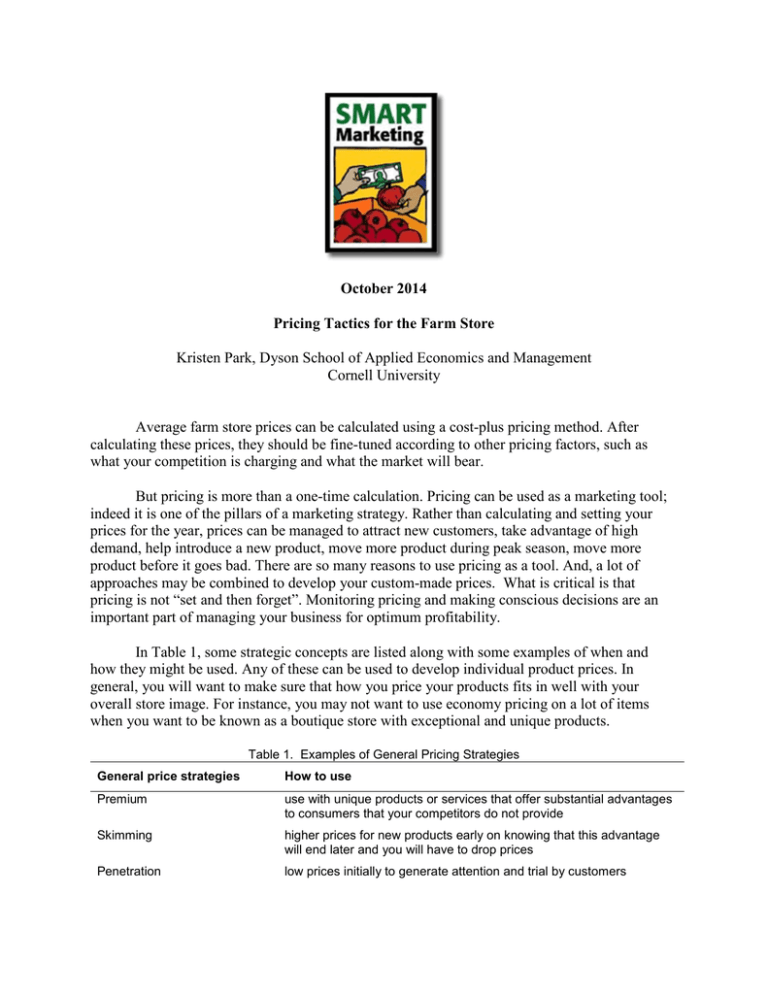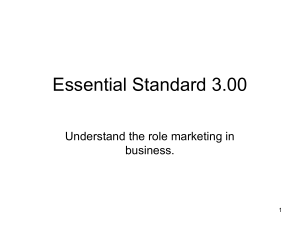October 2014 Pricing Tactics for the Farm Store
advertisement

October 2014 Pricing Tactics for the Farm Store Kristen Park, Dyson School of Applied Economics and Management Cornell University Average farm store prices can be calculated using a cost-plus pricing method. After calculating these prices, they should be fine-tuned according to other pricing factors, such as what your competition is charging and what the market will bear. But pricing is more than a one-time calculation. Pricing can be used as a marketing tool; indeed it is one of the pillars of a marketing strategy. Rather than calculating and setting your prices for the year, prices can be managed to attract new customers, take advantage of high demand, help introduce a new product, move more product during peak season, move more product before it goes bad. There are so many reasons to use pricing as a tool. And, a lot of approaches may be combined to develop your custom-made prices. What is critical is that pricing is not “set and then forget”. Monitoring pricing and making conscious decisions are an important part of managing your business for optimum profitability. In Table 1, some strategic concepts are listed along with some examples of when and how they might be used. Any of these can be used to develop individual product prices. In general, you will want to make sure that how you price your products fits in well with your overall store image. For instance, you may not want to use economy pricing on a lot of items when you want to be known as a boutique store with exceptional and unique products. Table 1. Examples of General Pricing Strategies General price strategies How to use Premium use with unique products or services that offer substantial advantages to consumers that your competitors do not provide Skimming higher prices for new products early on knowing that this advantage will end later and you will have to drop prices Penetration low prices initially to generate attention and trial by customers Economy low prices under extreme competition with similar commodities, may be also used when you need to reduce overhead As you develop your pricing strategy you will also want to think about the characteristics of the product and the characteristics of your customers and competition and how they may react to your price strategy. Table 2 lists some factors to keep in mind as you customize your prices. For example, you might want to understand that if you lower your price for potatoes, your sales might go up initially but only as customers stock up on them, after which sales will drop (demand elasticity). However, you may at the same time attract bargain hunters for the lower price on a staple item, and you can try to offer these new customers a reason to continue to shop at your farm store (competition). Another example of how to factor in some of these effects. You have a new yogurt that is outstanding while being no-fat. Unfortunately, the reference price, or the price that customers expect to pay is similar to grocery store prices and is much less than what you were going to price it as initially. You may lower the initial price to generate trial (penetration pricing) and use signs that say “regularly $1.75/cup; now $1.25/cup” to gradually start to change their price expectation (reference price). What is critical about this strategy is that you clearly state that the lower price is for a limited time and indicate what the price will revert to so that customers do not expect this pricing on a regular basis. Table 2. Factors that Affect the Relationship of Price to Sales Factor Definition Example Demand elasticity for product or How your product reacts to price changes items that are price elastic will respond sharply to changes in price, i.e. sales volume will change a lot depending on price; items that are inelastic will not respond a lot to prices changes, i.e. it doesn’t matter what the price is, the consumption is about the same. put elastic items on sale or promote them when you want to attract more customers or when you need to move more product; products that can substitute for one another maybe be elastic; some staple food items also respond to sales, but usually only in the short run as these are bought to “stock up” on and actually consumption only increases in the short run. Competition the other places your target customers can obtain the types of products you sell only lower prices to compete when you can out compete your competitor on factors other than price, in the long run, price wars do not benefit anyone Reference price The cost that consumers anticipate paying or consider reasonable to pay for a particular good or service. it is very hard to change a consumer’s reference price; if the reference price is much lower than your price, promote it heavily with added educational activities and demonstrations and taste testing; if the reference price is higher, you are losing out on sales and should increase your price Standardized products Many perishable foods such as meats and produce are not as standardized as processed foods. It is therefore easier to differentiate perishable products than processed products use price premiums when the product is more differentiated, as long as the product has more value to the customer Psychological effects emotional responses to price; prices ending in “9” many times do work; quality is associated with price and sometimes people become suspicious if the price is too low Cross product sales effects the effect of the price of one product on another product’s sales; a sale promotion for one product might cannibalize sales of a similar product to the extent that the store’s contribution margin and profits are compromised experiment with prices ending in “9”, such as $1.39 per and see what happens!; be a bit wary as calculating change takes more time and should not be used at the busy farmers markets if you put one product on sale, eg steaks, you may see a decline in hamburger sales; in preparation, you may have signs by the hamburger with lots of recipes and telling people that it freezes well, in order to help maintain the sales of hamburger “Smart Marketing” is a marketing newsletter for extension publication in local newsletters and for placement in local media. It reviews elements critical to successful marketing in the food and agricultural industry. Please cite or acknowledge when using this material. Past articles are available at http://agribusiness.dyson.cornell.edu/SmartMarketing/index.html.




